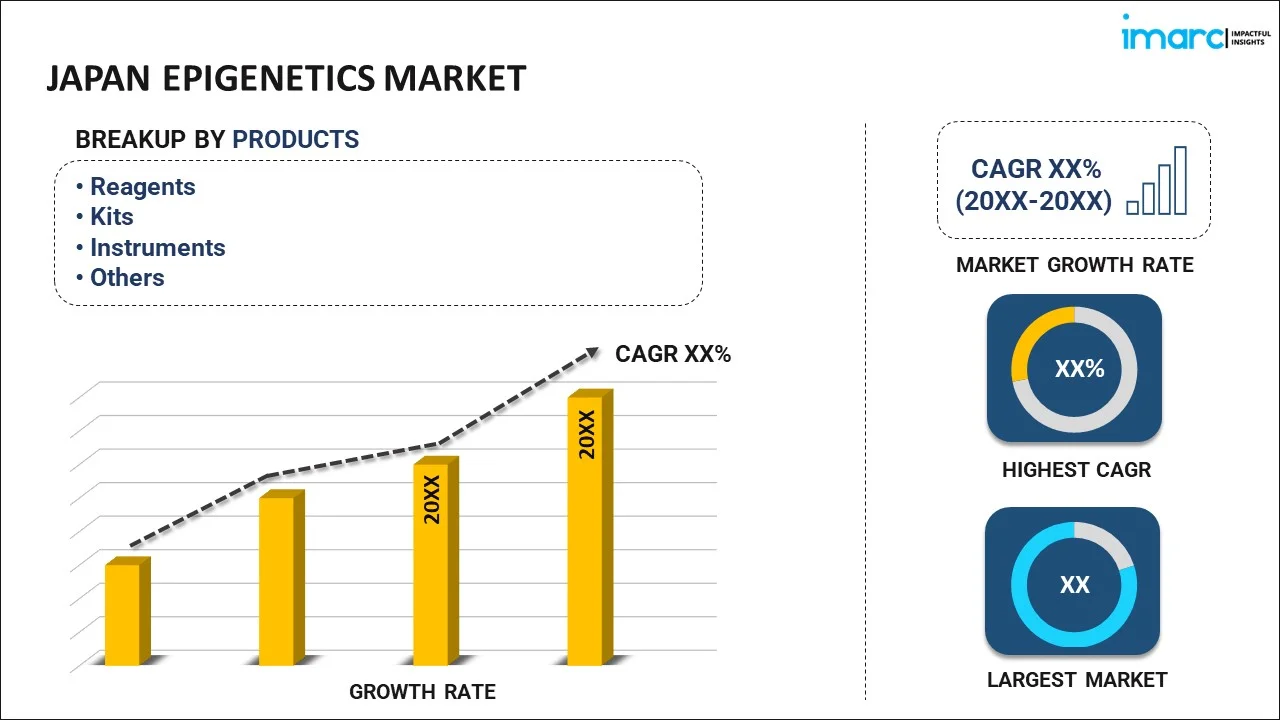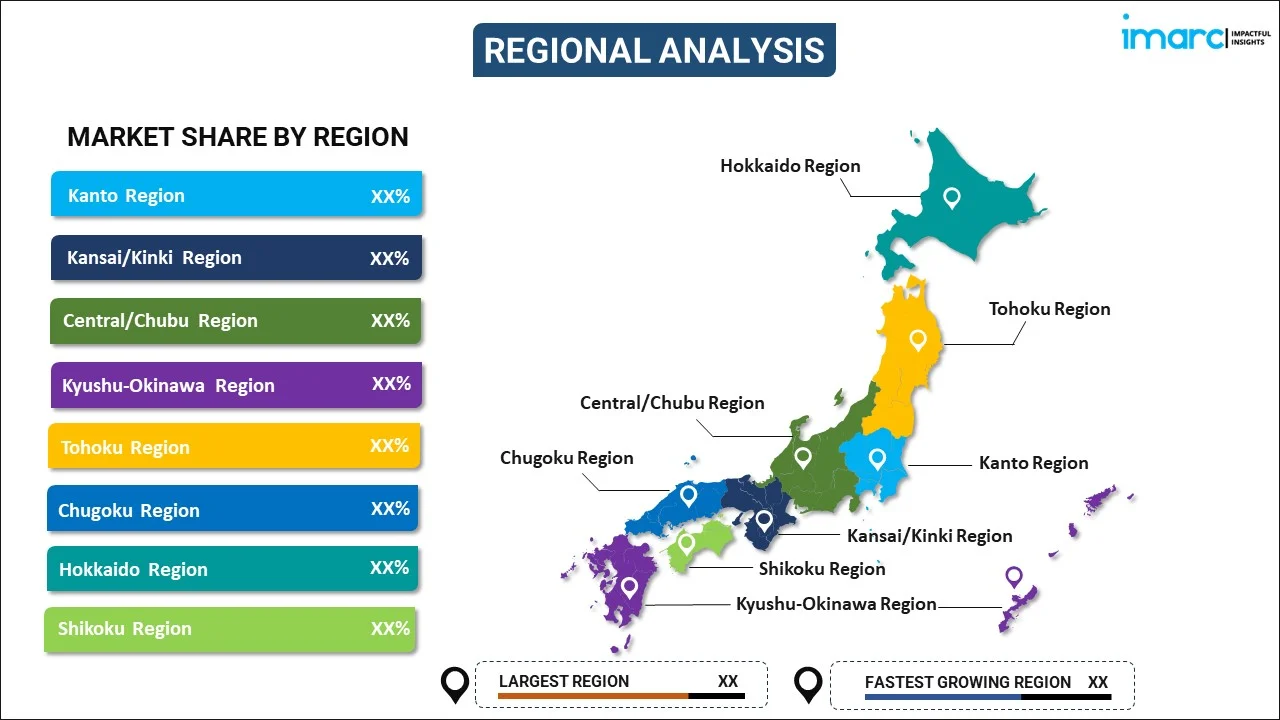
Japan Epigenetics Market Report by Product (Reagents, Kits, Instruments, Enzymes, Services), Technology (DNA Methylation, Histone Methylation, Histone Acetylation, Large Non-Coding RNA, MicroRNA Modification, Chromatin Structures), Application (Oncology, Non-Oncology), and Region 2026-2034
Market Overview:
Japan epigenetics market size reached USD 179.8 Million in 2025. Looking forward, IMARC Group expects the market to reach USD 490.0 Million by 2034, exhibiting a growth rate (CAGR) of 11.78% during 2026-2034. The escalating cases of chronic diseases such as cancer, diabetes, and cardiovascular diseases, coupled with the rising demand for epigenetic research and diagnostics to manage these conditions, are primarily driving the market.
|
Report Attribute
|
Key Statistics
|
|---|---|
|
Base Year
|
2025
|
|
Forecast Years
|
2026-2034
|
|
Historical Years
|
2020-2025
|
|
Market Size in 2025
|
USD 179.8 Million |
|
Market Forecast in 2034
|
USD 490.0 Million |
| Market Growth Rate 2026-2034 | 11.78% |
Epigenetics refers to changes in gene expression that occur without alterations to the underlying DNA sequence. It involves modifications to the structure of DNA and its associated proteins, which can turn genes on or off, influencing an organism's traits and development. Epigenetic mechanisms include DNA methylation, where methyl groups are added to DNA, and histone modifications, which alter the packaging of DNA in the cell nucleus. These modifications can be influenced by environmental factors, lifestyle choices, and even experiences across generations. Epigenetics plays a crucial role in various biological processes, such as embryonic development, cellular differentiation, and the regulation of gene activity. It also has implications for health and disease, as epigenetic changes can contribute to the development of diseases like cancer, cardiovascular disease, and mental health disorders. Understanding epigenetics has the potential to shed light on the interplay between genetics and the environment, providing insights into gene regulations and their impact on health and well-being.
Japan Epigenetics Market Trends:
The epigenetics market in Japan has witnessed remarkable growth in recent years, primarily owing to its potential to revolutionize understanding of gene regulation and its implications in various fields. Firstly, advancements in technology, such as next-generation sequencing and high-throughput assays, have propelled the epigenetics market forward. These tools enable researchers to analyze DNA methylation, histone modifications, and non-coding RNA expression at an unprecedented scale and accuracy. Furthermore, the rising prevalence of complex diseases, including cancer, neurological disorders, and metabolic conditions, has driven the demand for epigenetic studies. Epigenetic alterations have been linked to the development and progression of these diseases, creating a pressing need for targeted therapies and diagnostic tools. Additionally, the growing awareness of the role of epigenetics in personalized medicine has sparked interest among pharmaceutical companies, further stimulating the market. Moreover, government and private investments in epigenetics research have surged, fostering innovation and collaboration among academic institutions and biotechnology firms. This financial support has accelerated the development of epigenetic drugs and diagnostic solutions. Lastly, the increasing adoption of epigenetic testing in clinical settings, coupled with a growing aging population, is expected to drive the epigenetics market in Japan during the forecast period.
Japan Epigenetics Market Segmentation:
IMARC Group provides an analysis of the key trends in each segment of the market, along with forecasts at the country level for 2026-2034. Our report has categorized the market based on product, technology, and application.
Product Insights:

- Reagents
- Kits
- Chip Sequencing Kit
- Whole Genomic Amplification Kit
- Bisulfite Conversion Kit
- RNA Sequencing Kit
- Others
- Instruments
- Enzymes
- Services
The report has provided a detailed breakup and analysis of the market based on the product. This includes reagents, kits, (chip sequencing kit, whole genomic amplification kit, bisulfite conversion kit, RNA sequencing kit, and others), instruments, enzymes, and services.
Technology Insights:
- DNA Methylation
- Histone Methylation
- Histone Acetylation
- Large Non-Coding RNA
- MicroRNA Modification
- Chromatin Structures
A detailed breakup and analysis of the market based on the technology have also been provided in the report. This includes DNA methylation, histone methylation, histone acetylation, large non-coding RNA, microRNA modification, and chromatin structures.
Application Insights:
- Oncology
- Solid Tumors
- Liquid Tumors
- Non-Oncology
- Inflammatory Diseases
- Metabolic Diseases
- Infectious Diseases
- Cardiovascular Diseases
- Others
The report has provided a detailed breakup and analysis of the market based on the application. This includes oncology (solid tumors and liquid tumors) and non-oncology (inflammatory diseases, metabolic diseases, infectious diseases, cardiovascular diseases, and others).
Regional Insights:

- Kanto Region
- Kansai/Kinki Region
- Central/ Chubu Region
- Kyushu-Okinawa Region
- Tohoku Region
- Chugoku Region
- Hokkaido Region
- Shikoku Region
The report has also provided a comprehensive analysis of all the major regional markets, which include Kanto Region, Kansai/Kinki Region, Central/ Chubu Region, Kyushu-Okinawa Region, Tohoku Region, Chugoku Region, Hokkaido Region, and Shikoku Region.
Competitive Landscape:
The market research report has also provided a comprehensive analysis of the competitive landscape. Competitive analysis such as market structure, key player positioning, top winning strategies, competitive dashboard, and company evaluation quadrant has been covered in the report. Also, detailed profiles of all major companies have been provided.
Japan Epigenetics Market Report Coverage:
| Report Features | Details |
|---|---|
| Base Year of the Analysis | 2025 |
| Historical Period | 2020-2025 |
| Forecast Period | 2026-2034 |
| Units | Million USD |
| Scope of the Report | Exploration of Historical and Forecast Trends, Industry Catalysts and Challenges, Segment-Wise Historical and Predictive Market Assessment:
|
| Products Covered |
|
| Technologies Covered | DNA Methylation, Histone Methylation, Histone Acetylation, Large Non-Coding RNA, MicroRNA Modification, Chromatin Structures |
| Applications Covered |
|
| Regions Covered | Kanto Region, Kansai/Kinki Region, Central/ Chubu Region, Kyushu-Okinawa Region, Tohoku Region, Chugoku Region, Hokkaido Region, Shikoku Region |
| Customization Scope | 10% Free Customization |
| Post-Sale Analyst Support | 10-12 Weeks |
| Delivery Format | PDF and Excel through Email (We can also provide the editable version of the report in PPT/Word format on special request) |
Key Questions Answered in This Report:
- How has the Japan epigenetics market performed so far and how will it perform in the coming years?
- What has been the impact of COVID-19 on the Japan epigenetics market?
- What is the breakup of the Japan epigenetics market on the basis of product?
- What is the breakup of the Japan epigenetics market on the basis of technology?
- What is the breakup of the Japan epigenetics market on the basis of application?
- What are the various stages in the value chain of the Japan epigenetics market?
- What are the key driving factors and challenges in the Japan epigenetics?
- What is the structure of the Japan epigenetics market and who are the key players?
- What is the degree of competition in the Japan epigenetics market?
Key Benefits for Stakeholders:
- IMARC’s industry report offers a comprehensive quantitative analysis of various market segments, historical and current market trends, market forecasts, and dynamics of the Japan epigenetics market from 2020-2034.
- The research report provides the latest information on the market drivers, challenges, and opportunities in the Japan epigenetics market.
- Porter's five forces analysis assist stakeholders in assessing the impact of new entrants, competitive rivalry, supplier power, buyer power, and the threat of substitution. It helps stakeholders to analyze the level of competition within the Japan epigenetics industry and its attractiveness.
- Competitive landscape allows stakeholders to understand their competitive environment and provides an insight into the current positions of key players in the market.
Need more help?
- Speak to our experienced analysts for insights on the current market scenarios.
- Include additional segments and countries to customize the report as per your requirement.
- Gain an unparalleled competitive advantage in your domain by understanding how to utilize the report and positively impacting your operations and revenue.
- For further assistance, please connect with our analysts.
 Request Customization
Request Customization
 Speak to an Analyst
Speak to an Analyst
 Request Brochure
Request Brochure
 Inquire Before Buying
Inquire Before Buying




.webp)




.webp)












